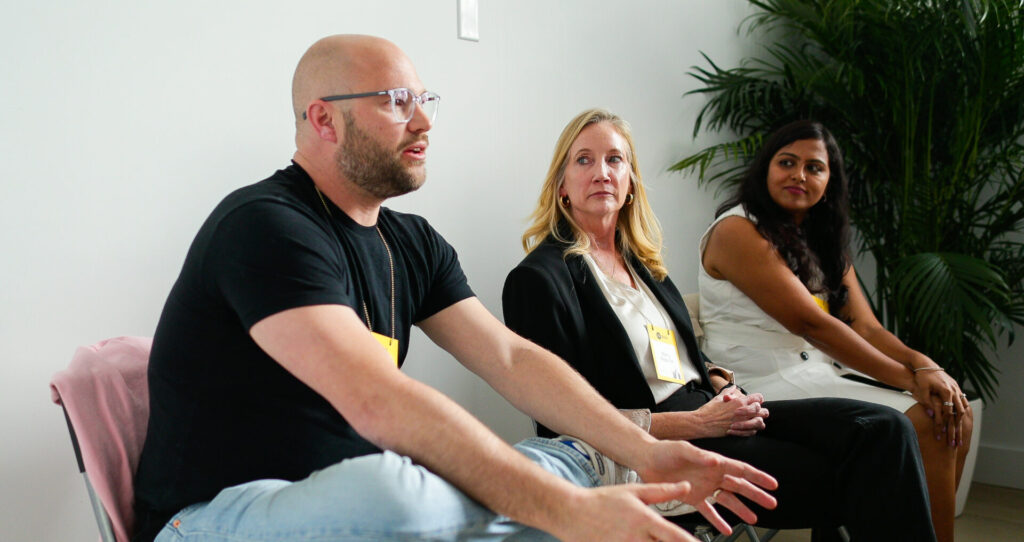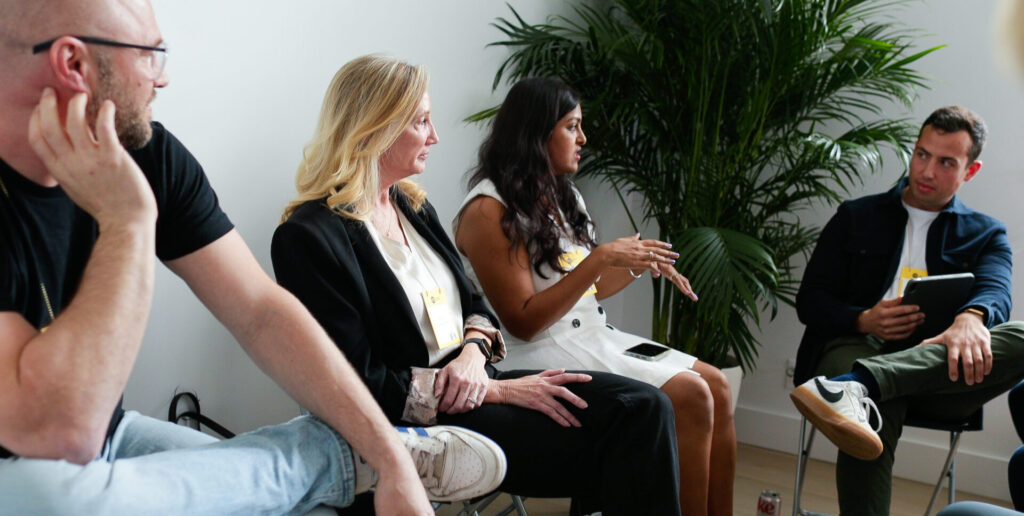Building a great company starts with people – but no one said it was easy.
At an RTP Global event in New York, we facilitated a conversation with three powerhouse Chief People Officers (CPO) to unpack the messy, high-stakes and often emotional realities of scaling teams. From hiring your first recruiter to letting go of a brilliant-but-toxic high performer, the panel didn’t hold back on sharing their thoughts.
Joining the conversation:
- Priti Shetty, Chief People Officer at WeWork India
- Marty Reaume, 4x Chief People Officer (Twilio, Fitbit, NetSuite) and startup advisor
- Nico Blier, former Chief People Officer at Revolut, Trustpilot, and Peakon
This candid conversation covers it all: how to hire for scale, when to prioritize diversity, how to navigate layoffs with empathy, and what it really takes to build culture in fast-changing, high-growth environments.
Here’s what every founder and early team should know.
Let’s start at the beginning. When you’re building out an early team, how do you know whether someone is right for now, or for the next stage?
Marty Reaume: For me, it’s a battle. You need a blend. Some people who can meet you where you are right now and others who have “done it” and are maybe a little bored where they are. You find the builders and you light them up with your vision. I’ve convinced so many to come back and do it again, and teach the next round how to scale.
Nico Blier: I have a little trick I use in interviews. I start by giving the candidate 15 minutes to ask me anything. You can ask whatever you want to know about me, about the company, why you’re doing this. The questions they ask give me all the data I need to understand them better. It helps me understand what they care about, what they know, and how curious they are. From there, I can tell whether they’re a fit for now or never.
Priti Shetty: We always look for passion and resilience. We scaled WeWork in India through incredible highs and lows, and the people who made it through weren’t just skilled – they were agile and deeply bought into our mission. If you’re not agile and resilient, you’re never going to make it through a startup experience.
And what about diversity? How early should founders prioritize it?
Marty: From day one. It just gets harder the longer you wait. You also need to think about the company you want to have. Do you believe that having a diverse company is going to make it a better company? You don’t have a single woman on your team? Good luck to you.
Think about the leaders that you hire and then the people that are in their networks. I always look for people whose LinkedIn networks don’t overlap with mine at all. That’s a sign they’ll open the door to new talent pools. And let’s be honest: if you say you care about diversity, but every hire is a white man from Stanford, you will get called out. Your trust bank will be depleted immediately. Either commit or be honest that you’re not there yet.
Priti: We made diversity a non-negotiable from the start. Today, 46% of our India team are women, 33% of our leadership are women, and we have LGBTQIA+ and disabled employees in many customer-facing roles. Why? For us, the philosophy has been that we try to replicate the diversity in our customer base within the organization. When you do that, you can get a deeper understanding of your customers’ needs and build it into your strategy or product. So diversity is actually a business lever for you. It helps to explore different product clients, different markets.
We back that up with real practices. Most of our buildings have gender-neutral bathrooms, and 75% include a dedicated mother’s room. Our goal is to create spaces that are welcoming and comfortable for everyone. When it comes to hiring, we’re intentional about reducing bias and building equity into our processes. For most roles, we ensure there’s at least one woman on the interview panel and we also run bias awareness sessions for hiring managers to support more objective decision-making.
We also incentivize referrals of candidates from underrepresented groups, especially at the manager level and above. By building diversity into our leadership pipeline, we’ve been able to grow more inclusive teams organically. For us, this approach is non-negotiable.

From experience, when is the right time to hire your first People leader?
Nico: If you’re planning to hire even five to ten people in a year, get an internal recruiter in. Otherwise, you’re building HR debt. Don’t waste money on headhunters – they don’t understand your culture, and their job is to make money off you, not find the best fit for your team.
Your only real competitive advantage is your culture. Why hand that off to someone external who’s giving the same pitch to every candidate? Instead, hire a “T-shaped recruiter” – someone who’s great at hiring but can also help build culture, shape performance management and support company planning.
A good internal recruiter can proactively build diverse talent pipelines, start engaging candidates early, and create real continuity as you scale. Think of it like marketing: you don’t wait until someone’s ready to buy, you start the relationship early.
Most importantly, shift your mindset. Hiring isn’t a cost centre… it’s the most critical investment you’ll make. People will leave. There’s no lifelong loyalty anymore. The only way to stay ahead is to always be recruiting.
Marty: And don’t go for the cheapest option. You want someone who can assess talent and say, “This person isn’t right for us.” That’s not admin work, it’s strategic. The best People leaders should be expensive.
Priti: Hiring is just one part. A strong CPO helps make difficult business decisions, manages risk, drives profitability, and partners with leadership across the board. You need someone who sees the whole business.
What about letting people go, especially in tough moments like layoffs? Do you have any advice on the best way to communicate this to employees?
Nico: My golden rule: no one should be surprised they’re being fired. If you’ve done your job as a manager, they should already know if they’re performing, or not, in terms of performance or culture.
Priti: We had to let go of 20% of our workforce when the pandemic hit. It was a terribly difficult thing to do and something we still regret. We were committed to making it as empathetic and respectful as possible: extended insurance, hot desk access for two months, counseling support, and personal references from leadership. Empathy matters. Doing it in a cold manner with just not authentic.
Nico: Layoffs will impact your culture – there’s no way around that. And we need to be more honest about it, especially in startups. Everyone says they want to work at a startup, but most people want the upside without the risk. The reality is: startups are high risk, high reward. That means hard decisions will happen, and pretending otherwise does a disservice to your team.
The worst thing you can do is pretend everything’s fine… throw a pizza party on Friday like nothing happened. No. Be real. Acknowledge that it’s difficult, that it’s personal, and that it’s part of building something new.
Marty: At that moment, the only person who matters is the person you’re letting go. You owe them grace and clarity. Set the conversation up properly, give them the dignity they deserve, and communicate like a human being.
Then, almost simultaneously, you need to communicate to the rest of the team about what happened, why, and what’s next. You can’t just move on in silence. Otherwise, people will spend all day speculating. Clear, honest communication helps people focus, and it builds trust – even in the hard moments.
Priti: One additional point is to know your audience. At WeWork India, 75% of our employees are Gen Z and the rest are millennials. How you communicate matters. Some people may not yet have the life experience to fully understand the bigger picture. So lay out the pros and cons. Contextualize your message. It makes a huge difference in how it’s received.

On this theme of reassessing talent and letting go, how do you know when it’s time to level up your executive team?
Nico: In high-growth environments, the company evolves faster than the people. When you start wondering “Is this person still right for the role?”, you probably already know the answer. Don’t wait too long.
Priti: I think we’ve become too impatient. Not everyone performs at 100% in every role or every phase. Sometimes, the right move is to coach or reassign, not replace.
Marty: Either way, be transparent. These conversations are an opportunity to reinforce your values. Let people know: we’ll all have these check-ins. We’ll talk about growth, fit, and the future. Sometimes that leads to a promotion, sometimes a pivot, sometimes a departure. But no surprises.
And what about those “brilliant assholes”? How do you manage top performers who are toxic?
Nico: You don’t. No assholes. Even if they’re the best in the world, if the people around them can’t thrive, it’s too costly. Brilliant jerks are not worth it.
Priti: Step one is actually giving them the feedback and a chance to change. But if they don’t, you move on. One person can drag the whole culture.
Marty: Every time I let someone like that go, the rest of the team rose to the occasion and we were so much better off. You can’t see it in that moment. It’s scary… you just think this is your rainmaker and you’re letting them go. But, I would place the money on the fact that you will be better off.
As a final question, a lot of teams and companies continue to function in a hybrid model, post-pandemic. How do you retain culture in hybrid and global environments? Any tips?
Priti: We use our own product! At WeWork India, Monday is our “collaboration day” when everyone comes into HQ. The rest of the week, they can use any of our 42 buildings or work remotely. Offices are no longer where you show up every day – they’re where you collaborate and connect.
Onboarding is key, especially in a hybrid world. We now run mixers for new joiners, storytelling sessions with leaders, and match employees with buddies before day one. That early culture imprint really matters.
Marty: When NetSuite scaled from three to 32 offices, one of the biggest questions we faced was: how do you make sure that no matter where you are – whether it’s London or San Francisco – you walk into a space and it feels like a NetSuite office?
It starts with values, but not the kind you frame and hang on the wall. Values should be lived, revisited, and woven into everyday behaviors. You have to ask: What does it feel like to work here? How do we collaborate? How do we treat one another? And why should someone choose to work here?
The best values are the ones people actually use. Jeff Lawson from Twilio has one I love: No shenanigans. It gives the team the vernacular to call each other out without creating conflict. You can be in a meeting and ask, “Is that a shenanigan?” and it opens up honest reflection in a low-friction way.
Keep those core principles consistent across offices, but also respect and celebrate local customs. An office in London will not be the same as an office in San Francisco but honor those things, celebrate them. The way you work, though, and the way you lead, and the way you treat people should feel the same everywhere.
A huge thank you to Nico, Marty and Priti for their insights. If you want to read more Talent and Culture insights, click here.

